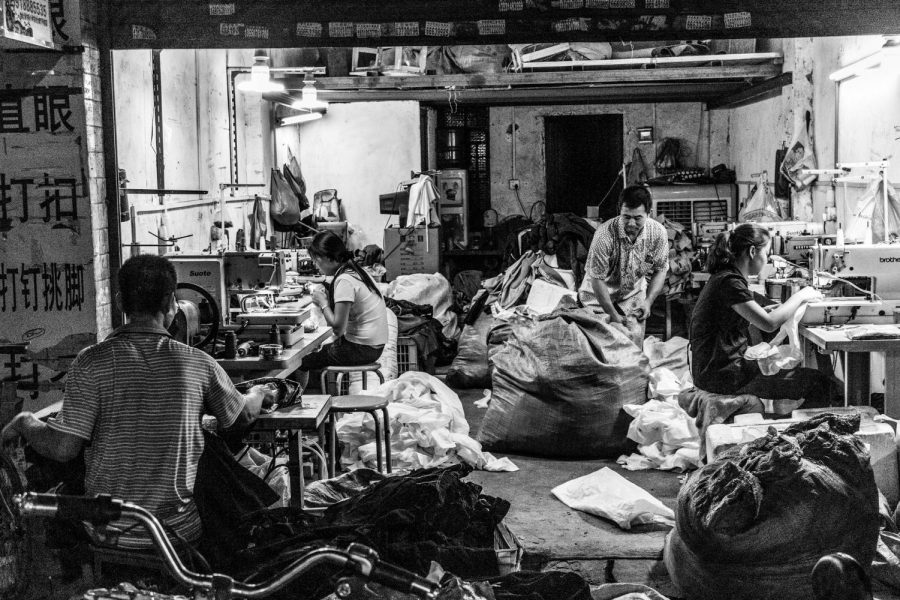Student Opinions: As easy as spending $5
Used with Permission via Flickr under Creative Commons
February 26, 2019
As Easy as Spending $5
“Come on Orpa! We are going to be late if you don’t hurry.” My sister Dina called out to me as I raced out the door. I did not want to be late to my first day of work at the factory. Mamma said that if I was late, I could be fired. Dina often reminded me that the money we were earning was going to help Papa get better and help us buy food. At just seven, I would be earning a little over $1 a day helping Mamma and Dina make clothes. By the end of the week I would have over $7! Mamma says that I am lucky to get a job so young, and that I cannot tell anyone that I am working because then Dina and I would no longer have a job. In Bangladesh, you can do light work when you turn twelve, and can work full time when you are fourteen. Dina turned eleven last week; now the factory is letting her work full time as long as no one else finds out, which means that she gets $2 a day, just like Momma!
Momma, Dina, and I walked along the dirt path that led to the nearest city, Savar Upazila. Walking to the Rana Plaza garment factory building, I was almost lost in the crowd, but was grabbed by my sister just before I was whisked away. “Hold onto my hand, and pay better attention to your surroundings.” She scolded. I knew that she wasn’t truly mad, just worried that I would get lost. We joined a line of women and children in front of a towering building. While we waited, I tried to count the different levels of the building. I got stuck on number six, and Dina leaned over and finished my counting for me. “…seven, eight, there are eight floors of the Rana Plaza. There are thousands of people working in the garment factory, so try not to get lost.”
Stumbling inside, I was hit with a sweltering wall of heat, and a strong sense of uneasiness. The concrete walls were cracked, and there was dirt and dust everywhere. I looked around and noticed that Mamma was missing, and questioned Dina about it. “She went to talk to the owner about the cracks and noises. She told him yesterday, but they’ve gotten worse today.” I began to notice what she was talking about. The cracks in the concrete ran deeper than I had originally thought, and there was a crumbling sound coming from somewhere that was hard to pinpoint because of the masses of people talking. Dina dragged me along to our station, claiming that Momma would be back in a bit. I was expected to quickly pick up on the task of sewing, and knew that if I did not, someone else would take my job.
There was a great noise, and the walls seemed to crumble before us. Before long there were thousands of screams, and the power was lost. People stumbled around in the dark, trying to grab anyone, hoping it was someone they knew. I was shoved to the ground by someone fighting their way out of the building. Once on the ground, it was difficult to breathe, and I began coughing, attempting to force air into my lungs. In the midst of my hacking, I was swept up by someone and dragged outside. Blinded and disoriented by the light, I hadn’t realized that I was crying until the woman holding me was wiping my face. Only a few minutes later did I process what had happened and take note that I could not see Dina or my Momma. Screaming for them I rushed back into the building, desperate to find them. Momma was trapped under a slab of concrete, and Dina was trying to pull her out. I took Momma’s other hand and aided in the effort. Just as she was freed, what remained of the building collapsed, burying us in the ruble.
On April 24, 2013; the Rana Plaza building collapsed in Savar Upazila, Bangladesh; killing and trapping 1,134 people. This tragedy is what brought to light the horrors that the fashion industry is responsible for all over the world. These crimes against humanity are going unbeknownst to most people in the Western world. The small number of people that do know are being manipulated by these companies and their advertising, or they simply believe that it is not their problem. Despite their belief, it is their problem, because they are the ones that chose to buy that $5 shirt, and they are the ones that chose to buy into fast fashion.
The fashion industry makes $3 trillion annually, and is bigger than you realize. There a select few people who are running the fashion industry, and they own every part of the business. They own and control the farmers who are growing the cotton, they own the people who are turning the cotton into fabric, they own the people who are then dying the fabric, and they own the factories and the factory workers turning that into cheap, easy to sell clothes. Right now, there is an epidemic in India. This is not a disease, but an effects that is brought about by the monopolies who govern the growth of cotton. This epidemic has caused birth defects, and the suicide of over 250,000 farmers. This is brought about by the monopoly placed on cotton. These farmers have cotton seeds sold and marketed to them every year saying that this seed will keep pests away. When it does not, they buy pesticides from the same company. After this, the soil is tainted and will need continued use of pesticides in order to grow cotton at all, and every year the amount of pesticides must be increased because it is simply not working anymore. These pesticides leak into the water of the surrounding areas, and contaminate the food and cause diseases in the people. In Punjab, a major cotton growing region in India, birth defects and cancer rates have increased since these pesticides were introduced. After a few years of the farmer buying seeds and pesticides, someone from the company will show up and claim that the farmer no longer owns the land because they owe the company so much money. This usually ends in the farmer ending his life, leaving many widowed wives behind. This monopoly has created the largest recorded wave of suicides in history.
The people who are working in the factories trying to create enough product to supply the demands made on them also receive the negative effects of fast fashion. In many third world countries, where it is cheaper to manufacture goods, there are no laws set up to protect the workers. They rarely get breaks, the factories are not air conditioned, and usually contain so many chemicals that it is harmful to the health of the people who work there. These people are paid less than $3 a day, which is less than half the hourly minimum wage in the United States. There are also very few labor unions in these countries, and for those that do exist, the unions do not hold much power over the factories. If a worker quits, they are easily replaced by someone else. One worker, who is in charge of a union, made demands to the factory owner, and she along with a few others were locked in a room and beat. She said that they used their fists, feet, chairs, scissors, tables, and whatever they could find to beat them. This is the risk that comes with fighting for fair treatment in garment factories. (The True Cost)
Those who run the companies see no harm in these sweat shops. Kate Ball-Young: former sourcing manager for Joe-Fresh said in an interview “Does it bother me that people are working in a factory, making clothes for Americans or for, you know, Europeans? Or that that’s how they’re spending their lives? Is that what you are kind of asking me? Um, no. I mean they’re doing a job. There are a lot worse things that they can be doing.” (The True Cost). This woman was a sourcing manager for a large fast fashion industry, and believed that these workers could be working in much worse industries. She believes that they are out of harm because they are sewing clothes and not mining. While her claims appear to be true, that does not mean that the way these factories are run is humane. The Rana Plaza building collapsed because the company ignored the workers pleas that there was something structurally wrong with the building, and ignored the evacuation alert. Because these companies care more about profit than human lives over 1,000 people were killed. I don’t know if you can classify this as a freak accident if the people in charge were warned from numerous sources that something was wrong with the building, and still sent the women in to work. The people responsible brushed this off as an accident while thousands of people lost their loved ones because of their negligence.
Even though people in the Western world think that we could not possibly be responsible for this, we are. We are the ones that buy into fast fashion and planned obsolescence. We still buy from the companies that are telling us to buy their new clothes and to throw away our old clothes. We have fallen into the trap of the $5 shirt, and we haven’t even realized it. That $5 shirt was made by someone who works for less than we would pay a toddler, who gets no breaks, who cannot complain, and who needs that job desperately. To put it into perspective, my sister explains the necessity for change very easily. She says “if you think about it, that shirt you just paid $5 for, had the cotton farmed by someone, was dyed by someone, was sewn by someone, was shipped to you by someone, and was sold to the department store for less than $5 in order to make a profit. So, my question is how much is each person paid when the shirt itself is sold for less then $5, and the big company also needs to make a profit?”





